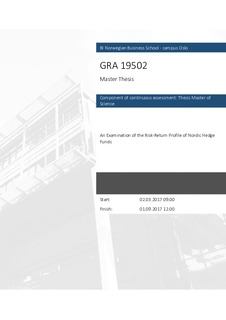An examination of the risk-return profile of nordic hedge funds
Master thesis
Permanent lenke
http://hdl.handle.net/11250/2476589Utgivelsesdato
2017Metadata
Vis full innførselSamlinger
- Master of Science [1621]
Sammendrag
The Nordic hedge fund industry has experienced a massive growth in assets under
management of approximately 370% between 2005 and 2016. The increased
interest for hedge funds as an investment vehicle may suggest that investors
believe that Nordic hedge fund managers are able to deliver risk-adjusted excess
returns. In this paper, we aim to provide a better understanding of the risk-return
profile of Nordic hedge funds. Using traditional linear risk factor models, we find
that Nordic hedge funds apparently creates statistical significant pre-fee alphas
between 6% and 8% during the period between January 2005 and December 2016.
However, empirical studies suggest that hedge fund returns exhibit significant
left-tail risk and that the traditional mean-variance framework fails to capture the
true risk profile of hedge funds. Furthermore, studies show that hedge fund returns
resembles the returns of an uncovered index put option. This further support our
belief that traditional linear risk factor models are inappropriate in order to
account for the performance of hedge funds and gives motivation to apply
alternative methods when studying the risk and return for Nordic hedge funds.
We show that a mechanic put-writing strategy largely accounts for the net-of-fee
alphas of Nordic hedge funds, but not the pre-fee alphas. However, this result
hinges critically on the accuracy of the NHX reporting process. A small degree of
return smoothing or presence of backfill bias or survivorship bias could
potentially leave the pre-fee alphas insignificant or even negative. These findings
enhances our understanding of hedge funds in aggregate, and they may provide
the basis for a more sober evaluation of Nordic hedge funds as investment
vehicles.
Beskrivelse
Masteroppgave(MSc) in Master of Science in Business, Finance - Handelshøyskolen BI, 2017
